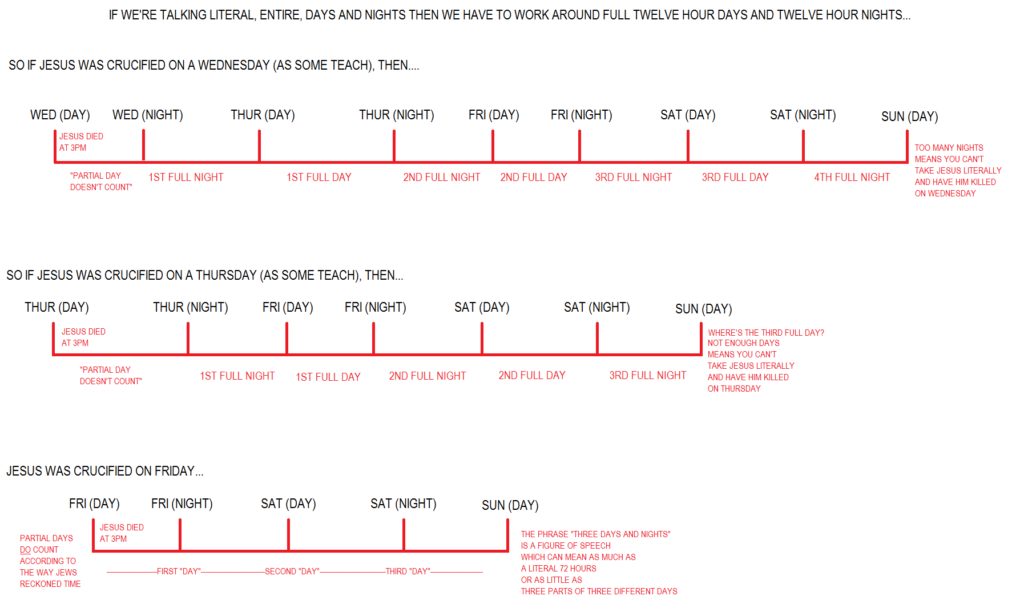Sunday in Bible Class we talked, among other things, about which day it was in which Jesus died. I said in class that I wished I had my trusty marker board because it’s much easier to chart these things visually than it is just with words.
So…here’s a more detailed explanation (with a chart below) to better make sense of it…
Though some argue for a Thursday death, followed by a burial lasting from Thursday night to Sunday morning, the most commonly accepted view (based around when the Passover fell that year and so forth) is that Jesus was killed on Friday afternoon and buried until rising on Sunday morning. No one disputes the resurrection happening on Sunday morning, since Mark (among others) makes it very clear that it occurred on the “first day of the week” (Mark 16:9).
Those who push for a Thursday crucifixion and burial do so because they take Jesus’ prediction to be buried “three days and three nights” (Matthew 12:40) literally. A Thursday night burial would mean, as they argue, three literal days in the tomb and three literal nights in the tomb (Thursday, Friday, Saturday) followed by a resurrection on Sunday morning just before sunrise.
There’s actually a problem with their reasoning, however. They argue that a Thursday-Sunday morning scenario allows for a true “three day and three night” burial, but it actually doesn’t since Jesus, in their scenario, is not buried until mid-way through Thursday. If we’re taking Jesus literally then a day should equate to as long as a night, which would mean Jesus would need to be in the grave for three “twelve hour” days and three “twelve hour” nights. Instead, according to the Thursday crucifixion defenders, He was buried for only a few hours on Thursday day, plus all of Friday and Saturday. That’s not three full days.
Those who argue for a Thursday burial will hand-wave that apparent contradiction by saying “a part of a day is a day.” And on that point all should agree whole-heartedly! More on that in a bit.
The only way to get a literal three days and three nights would be for Jesus to be killed on Wednesday but that would mean He would have to be raised on Saturday. Mark makes it clear, however, that Jesus was raised on the first day of the week, Sunday (Mark 16:9). If He was killed on Wednesday (and some try to argue that He was) and raised on a Sunday then He would have been in the grave for a total of three days and four nights, so that doesn’t fit the prediction of Jesus (three days and three nights) either (again, if we are taking Jesus’ usage of “days and nights” literally.
Therefore there is no reason to try and work out a literal three day/night structure. Instead we can reckon that Jesus was using the phrase idiomatically, and not referring to literal days and nights, but instead to a mere “three days” (or even, partial days) by Jewish reckoning. As always, the Bible is its own best commentary: Jesus Himself will describe the wonderful Sunday morning of His resurrection as “the third day” since He was crucified (Luke 24:20-21). Friday-Sunday is, by Jewish time-keeping, a span of three days. It’s a span of three partial days (part of Friday, all of Saturday and part of Sunday), but Jews regarded any part of a day as a day.
People raise issue because Jesus used the phrase “and three nights” when describing His time in the grave (Matthew 12:40) but, again, it should be remembered that the whole expression is a figure of speech. And this isn’t even the first time it’s used. For example, Matthew records that Jesus fasted in the wilderness for “forty days and forty nights” (Matthew 4:2). Mark, however, says Jesus only fasted for forty days (Mark 1:13). Phrases with “days and nights” attached to them are figures of speech and can be used to summarize how many partial-days are in question (not necessarily how many literal, entire days and entire nights).
The same reasoning can be applied to Jesus’ prediction of His death. He was in the grave for three partial-days. He calls it “three days and nights” in Matthew 12, but considering the wealth of other statements that simply word it as “three days” (such as Mark 8:31, Mark 9:31, Mark 10:34, Matthew 16:21, Matthew 17:23, Matthew 20:19, Luke 9:22, Luke 18:33, Acts 10:40, 1 Corinthians 15:4), it’s very reasonable to ascribe a “Friday burial, three partial day, Sunday resurrection” timeline to the whole event and regard the “three days/nights” statement as just how it was frequently used: a figure of speech.
Now having said that, you may think “but that’s such a weird thing to have as a figure of speech.” We have to remember, however, that their culture is very different from ours and they have their own little idiosyncratic phrases just like we do. Let’s not be too hard on the Jews for their little phrases; I mean we spent a whole generation using the word “bad” to mean “good.” We’re going to have a hard-enough time explaining Michael Jackson to future generations, but they’re going to be royally confused when they listen to the lead track off his “BAD!” album.
They have weird phrases; “days and nights” not being meant literally is just one of them.
There’s more that could be said, but that’s a good starting point of at least my view on it.
If it helps, here’s a chart I made, showing how there’s no way to reconcile Jesus being killed at 3pm (which He was according to Luke 23:44-46) and raised on Sunday with a literal “three full days and three full nights, no more no less” timeline. The phrase must have been metaphoric.
(click the picture to enlarge):


